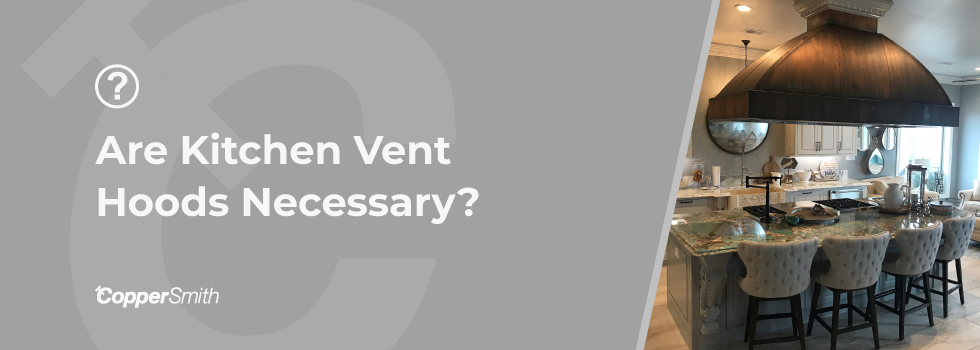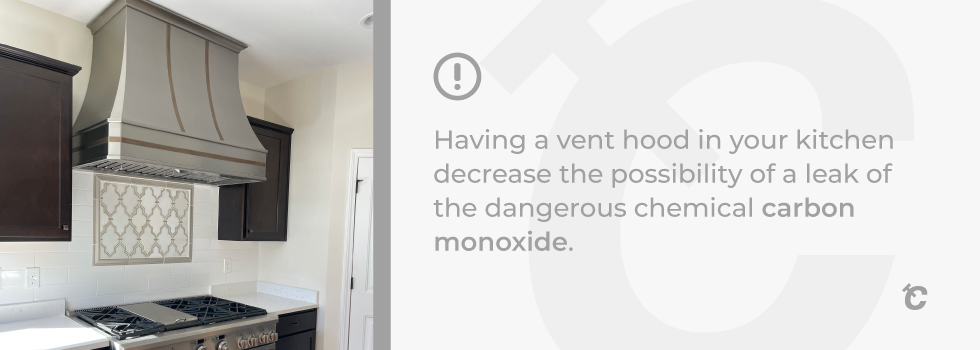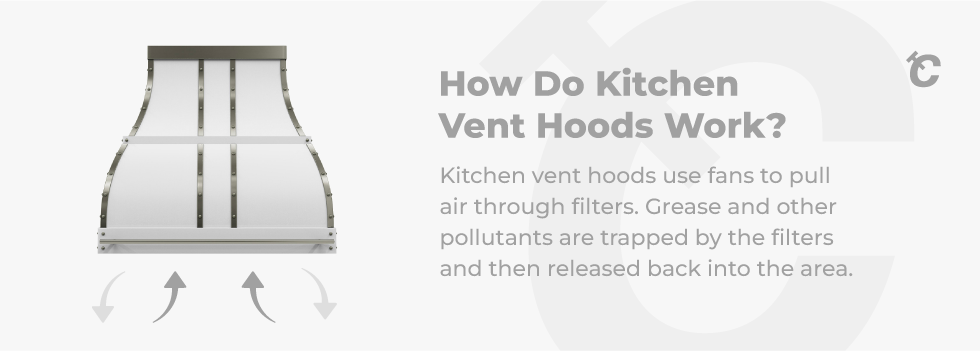
Most kitchen vent hoods are designed to remove grease from cooking fumes.
Having a vent hood in your kitchen has many advantages. First and foremost, it will decrease the possibility of a leak of the dangerous chemical carbon monoxide.
Additionally, vent hoods will improve the quality of the air within the structure.
This installation is designed to protect against grease fires. It will make cooking healthier and save you money. Another reason to get a vent hood is that it's highly aesthetically pleasing in kitchens.
If you're not sure whether or not you need a kitchen vent hood, then read on.
Do You Need a Kitchen Vent Hood?
A vent hood pulls smoke and odors away from the area and pushes air into the kitchen to keep it clean and free of harmful gases. Unfortunately, you'll be subjected to daily inhalation of those foul odors if you don't install one.
The best way to find out if you need a kitchen vent is to check your local building codes. Some states require that all kitchens have them installed or at least adhere to the proper ventilation requirements. Other states only need them for commercial kitchens.
In some areas, you can get an exemption if you prove that you already have a ventilation system.

Kitchen vent hoods come in two basic types:
1) The exhaust type: These are used when there's no other source of fresh air available. They pull smoke and odors outside through ductwork.
2) The recirculation type: This kind of hood uses fans to push air back into the room where it was generated. It doesn't use ductwork to move air around.
Both kinds of hoods are suitable for removing odors and toxins. Still, they each come with their own set of benefits and drawbacks. Let's take a deeper look at each type.
Exhaust-type kitchen vents
These types of hoods are usually found in restaurants and large commercial kitchens. They're also known as "ducted" vents because they use ducting to carry the fumes outside.
Advantages:
- They're easy to install.
- They're inexpensive.
Disadvantages:
- They can be noisy.
- They could be unable to tolerate very greasy conditions.
Recirculation-type kitchen vents
These types of hoods are typically found in smaller homes and apartments. They're also called "fan-assisted" vents because they use fans to circulate air throughout the kitchen.
Advantages :
- They're quiet.
- They're more efficient than exhaust-type hoods.
- They can handle higher levels of grease.
Disadvantage:
- They're difficult to install.
How Do Kitchen Vent Hoods Work?
Kitchen vent hoods use fans to pull air through filters. Grease and other pollutants are trapped by the filters and then released back into the area. This makes them much safer than traditional exhaust systems.
But how does this actually happen?
It creates smoke when you cook with oil, grease, or fat. Smoke contains tiny droplets of water vapor. These droplets condense when they hit cold surfaces. That means they form tiny drops of water in your kitchen.
When these droplets fall onto the floor, they create puddles. So long as there's sufficient moisture in the air, these puddles will eventually evaporate. But the puddles will stay around forever if there isn't enough humidity.
That's where kitchen vent hoods come in. They draw air through their filters and release it outside. Then they push fresh air back into the kitchen. So, you'll be breathing in cleaner air instead of breathing in the smoke.
Is There Any Advantage to Using a Kitchen Vent Hood?

A range hood improves air quality and reduces grease buildup in kitchens. Cooking fumes are removed from the air and captured before they enter the home.
As a result, grease and moisture buildup on surfaces such as the stovetop, oven door, and countertops are easily cleaned off.
Here are more benefits of installing kitchen vent hoods listed below:
- Improves Air Quality
- Reduces Grease Build Up
- Protects Against Carbon Monoxide Poisoning
- Prevents Fires From Starting
- Makes Cooking Healthier
- Saves Money
- Looks Great
- Helps Prevent Odor Problems
- Keeps Your Home Cleaner
Kitchen Ventilation Requirements
Some states require kitchen vent hoods or range hoods to be installed to meet ventilation requirements. Others allow exemptions based on existing ventilation systems. If you live in one of those states, make sure you know about the laws regarding kitchen ventilation.
If your local area does not require kitchen vents, you may still want to install one.
The cost of installing a kitchen vent hood varies depending on the size of your kitchen and how much work you plan to do yourself.
Check out these excellent custom range hoods that increase the home's worth and improve ventilation simultaneously. You can choose from several range hoods, some of which are made of stainless steel or copper, and you can even order custom hoods.
Why your kitchen needs ventilation
Cooking fumes can cause respiratory issues. A lack of ventilation makes kitchen environments more prone to water damage. Exhaust systems help prevent household pollutants from entering the home.
Kitchen ventilation systems remove harmful gases and aerosols from the air. This keeps them out of the home and away from people who spend time indoors.
When you cook, you create carbon monoxide (CO) gas. CO is colorless and odorless. But it's hazardous. Carbon monoxide exposure can cause headaches, nausea, vomiting, dizziness, confusion, seizures, coma, and even death.
When cooking with gas stoves, exhaust fans help prevent CO from building up inside the home. The fan pulls smoke and other combustion products through ductwork and out of the house.
Exhaust fans also help prevent water damage. Smokey smells, and soot can ruin wood floors and walls. An exhaust system removes this waste from the home.
What is required, and what isn't?
In most cases, you'll need a kitchen exhaust fan if you have a gas stove.
In addition to the fan, you may also need a kitchen vent hood. If you own a commercial kitchen, however, you almost certainly will need to have some sort of vent hood or range hood.
A kitchen vent hood is required by law in many states. Some states only require a kitchen vent hood if you have a gas oven. Other states require a kitchen vent hood regardless of whether you use gas or electric appliances.
Most states require a kitchen vent connected to a chimney or exhaust to pull smoke and other combustion products out of the home.
While some states require a kitchen vent connected to the roof or ductwork. They draw the smoke and other combustion products outside the home.

FAQs
Does a pizza oven need a hood?
Standard pizza ovens don't need hoods. Pizza ovens have different types of ventilation, and some lack exhaust fans. Others feature a bottom-mounted exhaust vent. Some have an exhaust fan.
Woodfire pizza ovens usually have a chimney to vent smoke. The size of your pizza oven could determine if you need a hood. Smaller ovens don't need them. Larger ones might.
What about a steam kettle? Does it need to be under a hood?
A steam kettle doesn't have to be under a hood. Many manufacturers make kettles without a hood; some even come with a built-in venting system. If a unit doesn't have a hood, it won't emit carbon monoxide.
Do I require a vent hood for my outdoor grill?
You probably don't, as you will be barbequing outside. As a result, the smoke and grease released during cooking will go out into the atmosphere and won't be trapped indoors. However, if you have a BBQ indoors or in a commercial kitchen, you will need a ventilation hood.
If I get an induction stove, do I still need a kitchen hood?
An induction cooktop is a good choice if you don't want to use a traditional stove. A range hood will help keep cooking odors out of the home and prevent grease buildup inside the cooktop. Induction cooktops produce less smoke than gas units, so they're considered safer options and usually won't require a kitchen vent hood.
Are kitchen vent hoods a necessity when using an electric stove?
No. Electric stoves are generally safe to operate without a kitchen vent hood. However, most models include a built-in exhaust system that pulls smoke and fumes away from the appliance.
Are ductless kitchen vent hoods effective?
Ductless hoods are effective at removing smoke and gases from kitchens. They work best when installed correctly. They can be expensive, but they do offer several advantages over conventional kitchen exhaust systems, including:
- Providing more efficient airflow. As a result, less power is needed to keep the same volume of air circulating through the system.
- Eliminating the need for ductwork. This makes installation easier and cheaper.
- Allowing for easy clean-up. You can easily clean the filters on these systems and replace charcoal filters in some models.
- Reducing noise levels.
Key Takeaways
In conclusion, kitchen vent hoods aren't necessary if you have a well-designed kitchen. But if you're looking to add a little extra ventilation to your cooking space, they're definitely worth considering.
They can also save you money over time because they reduce the smoke and grease inside your home. And, when you consider that they're relatively inexpensive, they may even be a worthwhile investment.
Go to our website to have a look at our collection of range hoods we have available.
